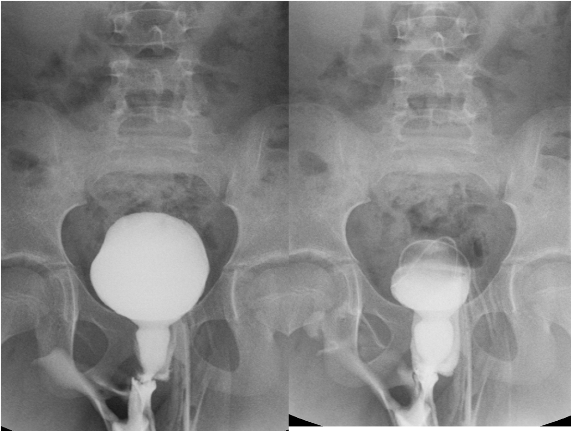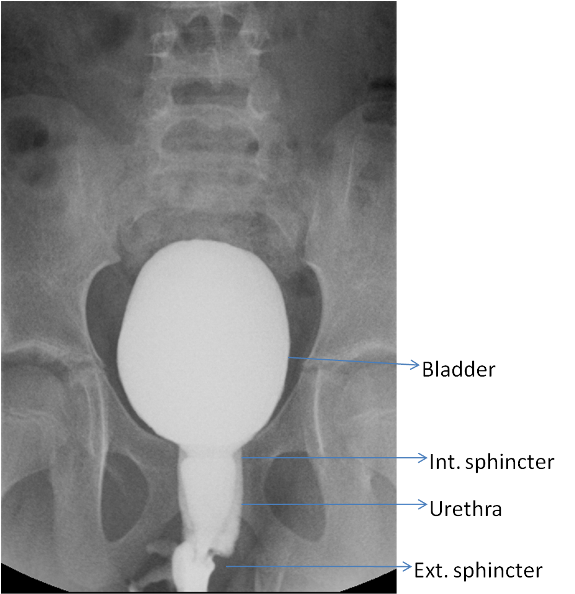Spinning Top Urethra
A 7-year-old girl with day and night urge incontinence. Voiding cystourethrogram performed. Low capacity of bladder and patient started voiding after 80ml of contrast injection in urinary bladder through catheter. Unusual dilatation of urethra, giving “spinning top” appearance.
Clinical History: A 7-year-old girl with day and night urge incontinence. Voiding cystourethrogram performed.

Low bladder volume with dilated urethra; no vesico-ureteric reflux; smooth out line of urinary bladder.

Intermittent emptying of urinary bladder, wide urethra

Voiding cystourethrogram
Findings:
Low capacity of bladder and patient started voiding after 80ml of contrast injection in ub through catheter. Unusual dilatation of urethra, giving “spinning top” appearance. Urinary bladder shows smooth outline. No vesico-ureteric reflux. No significant residual urine. The findings are in keeping with spinning top urethra.
Discussion:
Functional disorders of the bladder and urethral musculature can manifest as a delay in maturation of bladder control, hyperreflexia of the detrusor muscle with normal external sphincter activity (Urge Syndrome) and lack of coordination of the detrusor and the external sphincter (Detrusor-External Sphincteric Dyssynergia). The causes of these disorders are not certain.
The Urge Syndrome (Unstable Bladder) is a common disorder characterized by phasic uninhibited (involuntary) detrusor contractions early in the bladder filling phase and normal external sphincter activity. It is seen usually in children between 3 and 14 years (median 6 to 8 years) and is more common in girls than in boys.
The Detrusor-External Sphincteric Dyssynergia syndrome is less common and is characterized by an incoordination, or dyscoordination, in the activity of the detrusor muscle and that of the external sphincter. The two muscles tend to contract at the same time, preventing efficient emptying of the bladder and leading to a chronically increased intravesical pressure and obstructive changes in the bladder and upper urinary tracts similar to those seen in classical neurogenic bladder. This condition occurs with equal frequency in boys and girls and is commonly encountered between ages 2 and 13 years.
In the Urge Syndrome, clinical manifestations include frequent daytime voiding and urge to void that may result in episodes of incontinence. Nocturnal enuresis is common. The patients react to detrusor contractions by increasing the external sphincter and perineal muscular activity and assume characteristic postures or develop special maneuvers to prevent urine loss. Urinary tract infections are not uncommon. The increased pelvic floor activity contributes to the development of chronic constipation and soiling. The combination of urinary tract and bowel dysfunction may be referred to as the “dysfunctional elimination syndrome.” The patient can void on command, and the act of voiding is usually well coordinated. Bladder instability is a generally benign disorder that tends to resolve spontaneously with age.
With Detrusor-External Sphincteric Dyssynergia recurrent urinary infections, nighttime wetting, and daytime urgency and frequency are common manifestations. Episodes of urinary retention may occur, and an occasional patient presents with clinical signs of chronic uremia. Dribbling between voidings, possibly an overflow phenomenon, may be observed. Voluntary initiation of voiding may be difficult, requiring much straining. The distended and firm bladder is sometimes present on physical examination. Many children with this disorder also have bowel dysfunction manifested by chronic constipation and soiling. A wide range of behavioral or psychological disturbances is common and may contribute to the severity of the symptoms and affect the response to therapy.
Imaging:
In the Urge Syndrome, increased thickness of the bladder wall is demonstrated with ultrasound . On voiding cystourethrogram, the bladder is commonly smaller than normal and hypertonic, and may be smooth in outline or slightly trabeculated. Vesicoureteral reflux may be observed.
The patient can void with a sustained flow without residual urine in the bladder at the end of voiding. Signs and symptoms of transient detrusor contractions may be noted during the examination, including urge to void at lower bladder volumes, intermittent slowing or cessation or even reversal of the flow of contrast material in the tubing, and intermittent widening of the bladder neck and proximal urethra during bladder filling, “spinning top” urethra in females. The upper urinary tracts are usually normal.
With Detrusor-External Sphincteric Dyssynergia, ultrasound shows an increased thickness of the bladder wall and on VCUG the scout film may show a large amount of feces in the colon. The bladder is commonly enlarged, hypertonic, and variably trabeculated, and may point upward and to the right as in classic neurogenic bladder.
Unilateral or bilateral reflux is also common, occurring in about 50 percent of the patients, and the refluxing upper tracts are frequently dilated. Unilateral or bilateral upper tract dilatation is sometimes severe. The bladder neck and urethra appear normal, but the area of the external sphincter may show a constant or intermittent narrowing (spasm) of the urethra at that level with dilatation proximally.
In girls, the urethra may also assume a “spinning top” configuration. A large post-void residual is very common. Atrophy of the renal parenchyma may be present, and renal function may be decreased. The uncoordinated activity of the detrusor and external sphincter muscles tends to improve in late childhood or early adolescence, but by this time secondary changes in the upper tracts may have progressed to renal insufficiency.
Differential Diagnosis:
1. Neurogenic bladder
2. Posterior urethral valves or diaphragm
3. Cobb’s collar
4. Sphincter spasm
Treatment:
Current treatment consists of biofeedback training and an intensive and prolonged bladder retraining program, including frequent and “relaxed” voiding with complete emptying of the bladder and other forms of behavior modification.
Sushila Ladumor, MD, FRCR, consultant radiologist with multi-modality imaging experience, working in Medical Imaging Department, King Abdulaziz Medical City, Riyadh, Saudi Arabia.
References:
Bates DG., “The Bladder and Urethra”. Caffey’s Pediatric Diagnostic Imaging. Eleventh Edition.
The Reading Room Podcast: Current Perspectives on the Updated Appropriate Use Criteria for Brain PET
March 18th 2025In a new podcast, Satoshi Minoshima, M.D., Ph.D., and James Williams, Ph.D., share their insights on the recently updated appropriate use criteria for amyloid PET and tau PET in patients with mild cognitive impairment.
Contrast-Enhanced Mammography Study Reveals 24 Percent Lower Sensitivity with Moderate/Marked BPE
April 30th 2025In comparison to minimal or mild background parenchymal enhancement on contrast-enhanced mammography (CEM), researchers found that moderate or marked BPE was associated with a 12 percent lower AUC for breast cancer detection.
Study Examines CT-Based AI Detection of Incidental Abdominal Aortic Aneurysms
April 29th 2025The AI software Viz AAA offered a sensitivity of 87.5 percent in detecting abdominal aortic aneurysms on contrast-enhanced CT, according to new retrospective research presented at the American Roentgen Ray Society (ARRS) conference.










